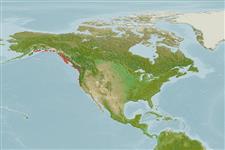>
Perciformes/Cottoidei (Sculpins) >
Agonidae (Poachers) > Bothragoninae
Etymology: Bothragonus: Greek, bostrykos = cure of lack of hair + Greek, gono = birth (Ref. 45335); swanii: Named after James G. Swan of Port Townsend, Washington (Ref. 6885).
More on author: Steindachner.
Environment: milieu / climate zone / depth range / distribution range
Ecologia
marino demersale; distribuzione batimetrica 0 - 18 m (Ref. 2850). Temperate; 60°N - 35°N, 155°W - 121°W
Eastern Pacific: Kodiak Island, Alaska to Carmel Bay, Monterey County, California, USA (southernmost range confirmed by J.R. Wolfe, pers. comm. 09/02).
Size / Peso / Age
Maturity: Lm ? range ? - ? cm
Max length : 8.9 cm TL maschio/sesso non determinato; (Ref. 2850)
Spine dorsali (totale): 2 - 5; Raggi dorsali molli (totale): 4-5; Spine anali 0; Raggi anali molli: 4 - 5; Vertebre: 32. Dorsal fins small; caudal fin rounded; pectoral fins large, supported well out from sides of body; pelvic fins very narrow and rays appear fused (Ref. 6885). Color very variable, depending on background; brown with dark bars, orange with bluish bars, or scarlet with brown bars (Ref. 6885).
Inhabits intertidal areas and to 18 m depth (Ref. 2850). Frequently caught in tide pools (Ref. 28197). Its food consists mainly of tiny crustaceans (shrimp and crab-like creatures) which are picked from the bottom or very close to it (Ref. 4930). Demersal spawner in nearshore habitats (Ref. 56049).
Life cycle and mating behavior
Maturità | Riproduzione | Deposizione | Uova | Fecundity | Larve
Demersal spawners.
Kanayama, T., 1991. Taxonomy and phylogeny of the family Agonidae (Pisces: Scorpaenifomes). Mem. Fac. Fish. Hokkaido Univ. (38)1-2:1-199. (Ref. 28197)
IUCN Red List Status (Ref. 130435)
Threat to humans
Harmless
Human uses
Informazioni ulteriori
BibliografiaAcquacolturaProfilo di acquacolturaVarietàGeneticaElectrophoresesEreditarietàMalattieElaborazioneNutrientsMass conversion
CollaboratoriImmaginiStamps, Coins Misc.SuoniCiguateraVelocitàModalità di nuotoArea branchialeOtolithsCervelliVista
Strumenti
Special reports
Download XML
Fonti Internet
Estimates based on models
Preferred temperature (Ref.
123201): 8.4 - 12.8, mean 9.8 °C (based on 177 cells).
Phylogenetic diversity index (Ref.
82804): PD
50 = 0.7500 [Uniqueness, from 0.5 = low to 2.0 = high].
Bayesian length-weight: a=0.01122 (0.00514 - 0.02450), b=3.04 (2.87 - 3.21), in cm total length, based on all LWR estimates for this body shape (Ref.
93245).
Trophic level (Ref.
69278): 3.6 ±0.59 se; based on food items.
Resilienza (Ref.
120179): Alto, tempo minimo di raddoppiamento della popolazione meno di 15 mesi (Preliminary K or Fecundity.).
Fishing Vulnerability (Ref.
59153): Low vulnerability (10 of 100).
